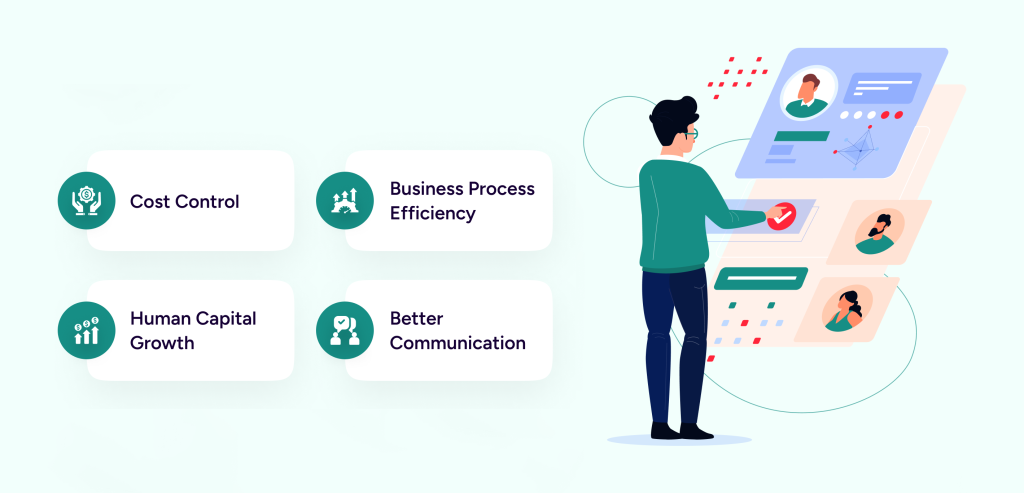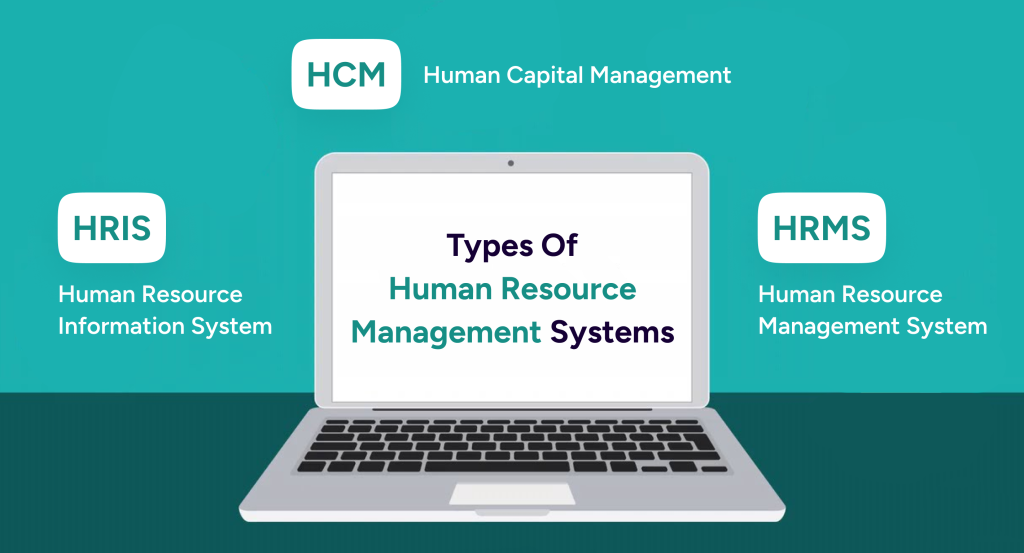HRMS software can automate up to 70% of repetitive HR tasks, such as payroll, leave management, and benefits administration. This frees up HR professionals to focus on more strategic initiatives that can drive business growth. Juggling multiple tasks and keeping track of employee information can be a daunting and time-consuming process. That’s where HRMS software comes in. As a top HRMS development company, Aipxperts has been at the forefront for over a decade when it comes to developing HRMS software for businesses and enterprises.
HRMS, or Human Resource Management System, is a powerful tool that can revolutionize employee management for businesses and enterprises. With its user-friendly interface and comprehensive features, this software simplifies and streamlines various HR processes, from recruitment and onboarding to performance evaluation and payroll management.
By centralizing all employee data in one secure and accessible platform, HRMS software eliminates the need for manual data entry, reduces administrative errors, and ensures data accuracy. It also provides customizable reporting and analytics, empowering business owners and HR managers with valuable insights to make informed decisions.
Moreover, HRMS software automates routine HR tasks, allowing businesses to save time and focus on more strategic initiatives. From generating employment contracts to tracking employee leave and attendance, this software increases efficiency and productivity, ultimately leading to a more engaged and satisfied workforce.
With all these benefits, incorporating HRMS software into your business is a game-changer. It’s time to revolutionize your employee management and take your business to new heights with this innovative HR solution.
Why Is There A Need For a HR Management Software?

In today’s competitive landscape, companies are laser-focused on optimizing every facet to unlock revenue potential. And rightfully so! Amidst this rapid evolution, dematerializing tasks is crucial, and HR is no exception.
Globally, Human Resource Management Software (HRMS) adoption is on the rise. Why? Because it elevates productivity, empowering HR to become a key growth driver. Here are a few reasons enlisted why you should invest in an HRMS.
1. Cost Control
Eliminate tedious manual work and unnecessary expenditures with HR software. Optimize processes, refine planning, and watch project success rates soar.
2. Business Process Efficiency
From personnel solutions and employee records to effortless payroll, HRMS empowers HR managers to juggle countless tasks with ease. Plus, employees gain self-service access to personal information, streamlining workflow for everyone.
3. Legal Compliance
Employer-employee regulations can be confusing, but you can navigate your way through them with confidence. HRMS simplifies complex challenges, enables flexible payroll management, and ensures seamless document flow.
4. Human Capital Growth
Unleash the hidden potential within your team. HRMS facilitates skill development, fosters learning, and sets your workforce on a path to personal and professional growth.
5. Communication Revolution
Ditch clunky channels and adopt seamless connectivity. HRMS empowers robust communication across all levels, anytime, anywhere. This not only enhances employee experience but also creates a truly connected, collaborative organization.
Types Of Human Resource Management Systems

1. Human Resource Information System (HRIS)
Focus: Employee data organization and management.
Functions:
- Maintain employee records (personal information, contact details, employment history, etc.).
- Track benefits and payroll information.
- Automate routine HR tasks like onboarding and offboarding.
- Generate reports on employee data.
Benefits:
- Improved data accuracy and accessibility.
- Reduced administrative workload for HR.
- Better compliance with HR regulations.
2. Human Capital Management (HCM)
Focus: Strategic workforce management and talent development.
Functions:
- All HRIS functions, plus:
- Recruiting and applicant tracking.
- Performance management and employee development.
- Learning management and training.
- Workforce analytics and reporting.
Benefits:
- Improved talent acquisition and retention.
- Increased employee engagement and productivity.
- Data-driven decision-making for HR.
3. Human Resource Management System (HRMS)
Focus: Comprehensive HR solution that combines HRIS and HCM functionalities.
Functions:
- All HRIS and HCM functions, plus:
- Payroll processing.
- Time and attendance tracking.
- Benefits administration.
- Self-service portal for employees.
Benefits:
- Streamlined HR processes and improved efficiency.
- Enhanced employee experience and satisfaction.
- Reduced costs and increased ROI for HR.
HRMS Development: Prioritizing Key Features

HRMS software offers a wide range of features that are tailored to meet the specific needs of businesses and enterprises. These features simplify employee management and enhance the overall HR experience. Here are some key features to look for when selecting HRMS software for your small business:
1. Recruitment and Onboarding
HRMS software streamlines the recruitment process by providing tools for job posting, applicant tracking, and candidate evaluation. It also facilitates seamless onboarding by automating the creation of employee profiles, and document management.
2. Attendance and Time Tracking
With HRMS software, tracking employee attendance and time becomes effortless. This software allows employees to clock in and out electronically, automatically calculates work hours, and generates accurate timesheets. It also enables managers to monitor attendance, track time-off requests, and ensure compliance with labour regulations.
3. Performance Management
HRMS software simplifies the performance evaluation process by providing a platform for setting goals, conducting performance reviews, and documenting feedback. It allows managers to track employee progress, provide continuous feedback, and identify training and development needs.
4. Employee self-service
HRMS software empowers employees by providing self-service portals where they can access and update their personal information, view pay stubs, and submit time-off requests. This feature not only increases employee satisfaction but also reduces the administrative burden on HR staff.
5. Payroll Management
HRMS software integrates with payroll systems to automate payroll processing, tax calculations, and direct deposit. It ensures accurate and timely payment of salaries, reduces manual errors, and simplifies tax reporting.
6. Employee Communication and Collaboration
HRMS software facilitates effective communication and collaboration among employees and departments. It provides tools for internal messaging, document sharing, and project management, enabling teams to work together seamlessly and enhance productivity.
Streamlining Employee Onboarding and Offboarding Processes
One of the key areas where HRMS development can make a significant impact is the employee onboarding process. Traditionally, onboarding new employees involves a lot of paperwork, manual data entry, and coordination between various departments. This can be time-consuming and prone to errors.
HRMS software simplifies and streamlines the onboarding process by providing a centralised platform where all employee information can be stored and accessed. From gathering personal details and emergency contacts to completing tax forms and signing employment contracts, everything can be done digitally. This not only saves time but also ensures accuracy and consistency in data collection.
Moreover, HRMS software allows HR managers to create customised onboarding checklists and workflows. This ensures that all necessary tasks and training are completed promptly, reducing the chances of important steps being overlooked.
Similarly, HRMS software can simplify the offboarding process when an employee leaves the company. By providing a standardized checklist and automating the necessary paperwork, this software ensures that all exit procedures are followed correctly. It also allows HR managers to revoke access to company systems and collect any company property, streamlining the offboarding process and protecting the company’s assets.
Automating Attendance & Time Tracking
Tracking employee attendance and time can be a cumbersome task for small businesses. Manual methods, such as paper timesheets or manual data entry into spreadsheets, are not only time-consuming but also prone to errors.
HRMS software automates attendance and time tracking, making the process much simpler and more accurate. Employees can clock in and out electronically using biometric devices, web-based applications, or mobile apps. This eliminates the need for manual timesheets and ensures accurate recording of work hours.
Moreover, HRMS software can integrate with other systems such as access control or project management tools, further streamlining the attendance and time tracking process. For example, employees can use their access cards to clock in and out, and the HRMS software automatically records their attendance data. This not only saves time but also reduces the chances of errors or fraudulent practices.
Additionally, HRMS software provides self-service portals where employees can view their attendance records, check their leave balances, and submit time-off requests. This empowers employees to take control of their own attendance and time management, reducing the administrative burden on HR staff.
Enhancing Employee Communication and Collaboration With HRMS Development
Effective communication and collaboration are crucial for the success of any organization, regardless of its size. HRMS software provides tools and features that enhance employee communication and collaboration, increasing productivity and engagement.
One of the key features of HRMS software is the employee self-service portal. This portal allows employees to access important information, such as company policies, benefits, and training materials, at their convenience. It also provides a platform for internal messaging, document sharing, and collaboration on projects. Employees can communicate with their colleagues, share ideas, and work together on tasks, regardless of their physical location. This promotes a sense of teamwork and fosters a collaborative work environment.
Moreover, HRMS software can integrate with other communication and collaboration tools, such as email clients, instant messaging platforms, or project management software. This allows employees to access all relevant information and communicate seamlessly across different platforms. For example, an employee can receive email notifications about important HR updates or project deadlines directly within the HRMS software.
Additionally, HRMS software can facilitate the creation of employee directories or organizational charts, making it easier for employees to find and connect with their colleagues. This promotes transparency and helps employees build professional relationships across different departments or teams.
The Aspects To Consider When Developing Your HRMS Software
Prioritizing the right aspects while building your HRMS software is crucial to ensure its successful implementation and adoption. Here are some factors to consider when narrowing down the features of the HRMS software:
1. Scalability
Ensure that the HRMS software can accommodate the growth of your business. It should be able to handle an increasing number of employees and adapt to your changing needs.
2. User-friendly interface
Ensure that the platform has a user-friendly interface and intuitive navigation. This will make it easier for your employees to learn and use the software effectively.
3. Integration capabilities
Integrating the HRMS software with your existing systems, such as payroll or accounting software can play a . This will streamline data transfer and ensure data consistency across different platforms.
4. Customization options
Look for HRMS software that allows you to customize workflows, forms, and reports to meet your specific requirements. This will ensure that the software aligns with your business processes and needs.
5. Data security
Ensure that the HRMS software has robust security measures in place to protect sensitive employee data. It should comply with data protection regulations and provide features such as data encryption and access controls.
6. Customer support
Consider the level of customer support provided by the HRMS development partner. Look for HRMS development companies that offer training, implementation assistance, and ongoing technical support to ensure a smooth transition and optimal usage of the software.
7. Cost
Evaluate the cost of the HRMS software, including licensing fees, implementation costs, and ongoing maintenance fees. Consider your budget and the return on investment that the software can provide.
How Much Does it Cost to Develop An HRMS Software?
Every business deserves an HRMS that empowers growth and streamlines operations. However, understanding that the cost of developing an HRMS software is also a crucial factor. That’s why we offer a range of flexible solutions tailored to your specific needs, ensuring you don’t overspend on features you won’t utilize.
The efficiency of the HRMS software lies in its modularity. Whether you’re a nimble startup or a well-established company, you can choose the functions that matter most, from core employee data management and payroll processing to robust performance management and recruitment tools. This customized approach means you only pay for what you need, ensuring your investment aligns perfectly with your HR priorities.
Of course, we understand the complexity of cost comparisons. Pricing models can vary, and comparing apples to oranges across platforms can be daunting. That’s why finalizing the features you want to include in the HRMS software is crucial.
Here is the breakdown of the features that can be incorporated into HRMS software. You choose the modules that shape the functions and features you need. Here’s a breakdown of key modules to consider:
1. Core HR
Employee Database: Manage employee profiles, contact information, emergency contacts, demographics, and job details.
Document Management: Securely store and access employee documents like contracts, offer letters, certificates, and performance reviews.
Organization Chart: Visually map reporting structures, teams, and department hierarchies.
Leave Management: Track vacation, sick leave, personal leave, and other types of leave with approval workflows.
2. Payroll and Benefits
Payroll Processing: Automate salary calculations, deductions, tax withholdings, and direct deposits.
Benefits Administration: Manage employee benefits enrollment, deductions, and claims processing for health insurance, retirement plans, and other benefits.
Tax Compliance: Ensure accurate tax reporting and filing with built-in compliance tools.
3. Recruitment and Onboarding
Applicant Tracking System (ATS): Manage job postings, applications, resume screening, and interview scheduling.
Onboarding Process: Streamline the new hire experience with automated tasks, document collection, and training workflows.
Performance Management: Set goals, track progress, conduct performance reviews, and provide feedback through a structured system.
4. Talent Management and Development
Learning Management System (LMS): Deliver online training modules, track course completion, and manage employee development plans.
Succession Planning: Identify and develop high-potential employees for future leadership roles.
Skill Management: Track employee skills, competencies, and certifications, and facilitate talent pool creation.
5. Employee Engagement and Collaboration
Internal Communication Platform: Facilitate company-wide announcements, team communication, and employee feedback channels.
Employee Recognition and Rewards: Implement programs to recognize achievements, boost morale, and motivate employees.
Pulse Surveys and Feedback Tools: Gather employee feedback on various aspects of work and organizational culture.
6. Time and Attendance
Time Tracking: Track employee hours worked, overtime, breaks, and schedule adherence with various methods like biometric devices or mobile apps.
Absence Management: Record and manage absenteeism, track trends, and identify potential issues.
Shift Scheduling: Create and manage employee schedules, accommodate requests, and ensure optimal staffing levels.
7. Analytics and Reporting
HR Dashboards: Generate data visualizations and reports on key HR metrics like employee turnover, engagement, absenteeism, and hiring costs.
Talent Analytics: Gain insights into workforce trends, identify skill gaps, and optimize talent management strategies.
Compliance Reporting: Generate reports for regulatory compliance and audits.
The cost of developing an HRMS depends on the complexity of the software and the features you want to incorporate into your software. While the cost is an important factor, considering the return on investment is also crucial. Our HRMS development services are designed to pay for themselves through increased efficiency, reduced errors, and improved employee satisfaction.
Investing in an HRMS shouldn’t be a guessing game. Let us guide you through your options, tailor a solution that fits your budget and needs, and empower your organization to reach new heights. We’re confident that with the right HRMS partner, the cost becomes less of a concern and more of a stepping stone to success.
Conclusion: The Future Of Employee Management With HRMS Software Development
HRMS software is a game-changer for businesses and enterprises when it comes to employee management. It revolutionizes HR processes by simplifying and streamlining various tasks, from recruitment and onboarding to performance evaluation and payroll management. By centralizing employee data, automating routine tasks, and providing valuable insights, HRMS software enhances efficiency, productivity, and employee satisfaction
With the ever-increasing demands and complexities of employee management, small businesses cannot afford to ignore the benefits of HRMS software. It is a strategic investment that can help businesses stay competitive, and attract and retain top talent. By building the right HRMS software for your company and leveraging its powerful features, you can revolutionize your employee management and take your business to new heights.
Partner With Aipxperts To Build Your HRMS Development
Aipxperts is one of the top HRMS Software development companies in Ahmedabad. With over a decade of experience in building HRMS software for various businesses and enterprises, we have a proven track record of building employee-friendly HRMS software that has played a pivotal role in streamlining and enhancing the HR processes of the organisation.
Our team of HRMS software developers have a solid grip on understanding the needs and requirements of the HRMS software and has developed a multitude of platforms for various companies. Connect with us over a free consultation call and let us help you with your HRMS development by creating a platform tailored according to your needs.
A Complete Guide to HRMS Development: Hire experienced HRMS Software Developers from Aipxperts. Contact us for project estimates and enjoy a 15-day risk-free trial period.











